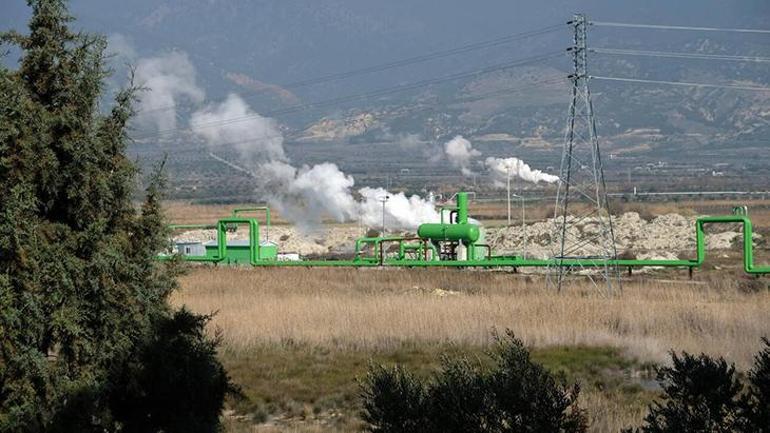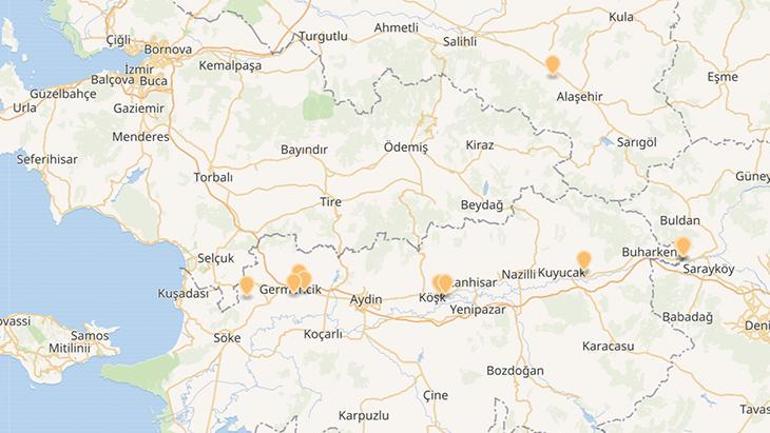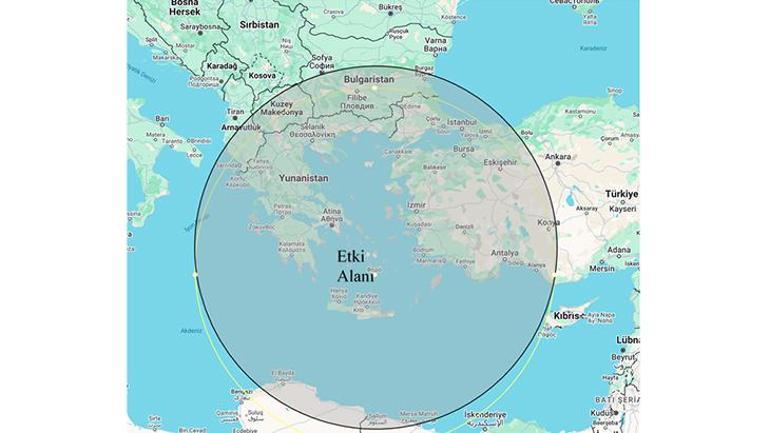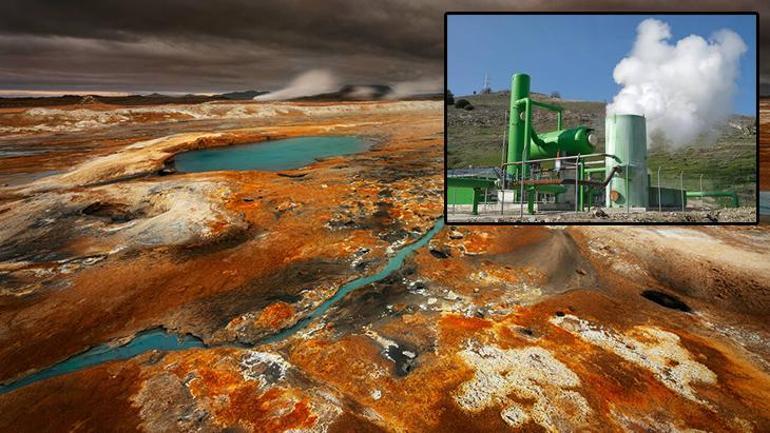Will the pressure in Santorini hit Turkey? It destroyed South Korea and caused a 10-year winter

Zeynep Dilara Akyürek / Milliyet.com.tr – Since January 28, 2025, the Aegean Sea has been under the influence of unceasing tremors. The concern of the islands, which have been declared a state of emergency, is that natural events such as earthquakes, volcanoes and tsunamis will turn into disasters. However, in addition to the visible data reflected in the earthquake lists, there is also a face of danger that can only be seen with scientific examination and follow-up. Geothermal, which is actually one of the underground resources that does not pose a danger and provides energy production when used correctly, is a wealth that Turkey and Greece have. Turkey, which is 1st in Europe and 4th in the world in terms of geothermal, started talking about possible volcanic eruptions, tsunamis and major earthquakes after the earthquake storm in Santorini. Could the geothermal resources, which are directly related to the faults, have been triggered by Santorini and a pressure increase at a level that would lead to a possible danger has been observed? When and what kind of events could geothermal cause in Turkey? Gebze Technical University Civil Engineering Department Faculty Member, Geophysical Engineer and Earthquake Scientist Assoc. Prof. Dr. Savaş Karabulut told the geothermal reality in the Aegean to Milliyet.com.tr .

THE EXPLOSION THAT KILLED 8 THOUSAND PEOPLE, CREATED A 10-YEAR WINTER!
Since January 28, more than 3,524 earthquakes have been recorded around Santorini and Columbo. The earthquakes, the largest of which was 5.3, brought many different dangers to mind. Earthquakes, volcanic eruptions and tsunamis were also among the much-talked-about potential dangers. However, no one was talking about 'geothermal', of which Turkey is number 1 in Europe. However, earthquakes and the faults that produce them were directly related to 'geothermal'. While the earthquakes in Santorini continued, one of the dangers that was not given much attention was related to geothermal resources. Could the pressure and temperature increases underground turn 'geothermal' into a danger and then a disaster?
Assoc. Prof. Dr. Savaş Karabulut, geothermal and Santorini, “The northeastward movement of the African continent and the Aegean microplate caused the heat flow to reach a value of 80 mw/M2 in the Hellenic arc and the Aegean Sea. In addition, a large amount of gas is released in the Aegean volcanic arc through hydrothermal channels in very shallow waters (up to 200 m depth). The most important of these gas outlets come from Milos, Santorini and Incirli (Nysiros) Island. This hydrothermal structure, which is formed as a result of intense seismic and volcanic activity, leads to the formation of reservoir environments with high geothermal potential. Geothermal potential was encountered in the south of Santorini Island. Wells with a depth of 200 meters were drilled and it was observed that the water temperature reached 16 degrees Celsius at a depth of 100 m. This situation indicates that it has a high geothermal gradient. "There are areas with hot spring water and steam outlets on Nea Kameni Island. Geothermal areas are also directly related to faults. In fact, they are fed by sources in areas where active faults are located and on the side where the fault operates," he explained. Assoc. Prof. Dr. Karabulut continued his words as follows:
"According to the volcanic eruption index, the magnitude of the eruption that occurred in Santorini in the 1610s was determined as 7. The material released is thought to be 100 tons cubic meters. It is known that the largest volcanic eruption in the world was the Toba eruption. The volcanic eruption that occurred in Lake Toba on the Indonesian island of Sumatra approximately 70 thousand years ago caused the world to experience winter for 5-10 years. There was a great loss in the world's population, 1-2 centimeters of dust covered the atmosphere, and sulfur dioxide reached 32 km high. 2.1 million years ago and 640 thousand years ago, the most well-known and best-studied volcanic eruption occurred in Yellowstone in Western America. The eruption that occurred 640 thousand years ago had the highest eruptive magnitude and was determined as 8. A volcanic eruption of magnitude 7 occurred in Tambora on the Sunda Island of Indonesia on April 5, 1815, marking the beginning of the 'summer without summer'. It was recorded that the caldera (collapsed volcanic basin) was 6 km wide, 1250 meters deep, 2851 meters high and that volcanic ash and smoke erupted up to 43.5 km high due to the eruption. It was recorded that at least 8,000 people died from the eruption and the drought and diseases that followed. 100 cubic kilometers of ash, pumice and gas were released and 60 megatons of sulfur dioxide were mixed into the air. A year later, air temperatures had decreased by 3 degrees from normal. The biggest volcano threatening our country is the volcanic activity in and around Santorini. Santorini's activity in the 20th century is equivalent to a magnitude 2 volcano.

'FORCED GEOTHERMAL SYSTEMS CAN CAUSE EARTHQUAKES'
Due to its geological and geographical location on an active tectonic belt, Turkey is in the top 5 in the world in terms of geothermal resources. There are more than 1000 natural outlets in Turkey that contain various geothermal resources at various temperatures. 78 percent of the potential areas are in Western Anatolia, 9 percent in Central Anatolia, 7 percent in the Marmara Region, 5 percent in Eastern Anatolia and 1 percent are active in other regions. Since 90 percent of geothermal resources are at low and medium temperatures, they are suitable for direct use, namely heating, thermal tourism and various industrial applications. The remaining 10 percent is ideal for indirect applications, namely electrical energy production. However, it is extremely important to produce energy using geothermal resources or to use and store these resources safely. The answer to the 'danger' questions asked by many people is hidden in a small detail. Yes, geothermal can be dangerous in some cases. However, this is a danger that only arises as a result of 'challenging nature'!
Assoc. Prof. Dr. Savaş Karabulut also explained this detail. Assoc. Prof. Dr. Karabulut said, “In fact, geothermal systems can be called ‘natural hot pools/spas’ of the earth. However, man-made (forced geothermal) systems such as natural geothermal waters have been developing in recent years. There is also information that the hot dry rock-supported forced geothermal system in Basel, Switzerland, triggered an earthquake and caused damage to the surrounding structures, albeit small. Although it has been stated in the literature that developed and hot dry rock systems have potential in Central Anatolia in our country, they will not be much more useful than the system that will be obtained by using water and steam from natural geothermal resources. These systems, which operate with a man-made and forced system, have the capacity to produce triggered earthquakes, and may even cause geothermal systems to be given a bad name in our country with high disaster potential and to be banned as in Basel, by triggering large earthquakes in regions with high seismic risk. Water pressed into the ground with high pressure has the potential to trigger even a large earthquake. "In our country, there are almost no geothermal enterprises that will take any precautions on this issue and constantly monitor earthquake activity. It is important to provide this legal regulation as soon as possible," he said.

CREATED AN EARTHQUAKE IN SOUTH KOREA! 'SUPERIOR TO SUN AND WIND'
The figures of the Organization for Economic Co-operation and Development (OECD) keep Turkey among the countries with growing energy demand. According to the lists, China is in first place and Turkey is the second country where demand is increasing. Since geothermal systems are environmentally friendly and economical, they can be used efficiently. However, the important detail here is that geophysical engineers can also closely monitor the process and help avoid the danger. Because the geothermal energy project caused a devastating earthquake in South Korea in 2017. William Ellsworth, a professor at the Stanford Earth Institute and co-director of the Center for Induced and Triggered Seismicity, said, "We have known for half a century that the process of pumping the Earth at high pressure could cause earthquakes." It happened exactly as Ellsworth said, and when high-pressure fluid was injected underground, one well produced a crack network as planned. However, the water injected into the other well activated a previously unknown fault that passed right through the well. The pressure moving towards the fault reduced the forces that would normally make it difficult for the fault to move. In other words, it was too late. Smaller earthquakes continued for weeks, even after operators turned off pumps or reduced pressure. The earthquakes grew larger each day, eventually ending in a devastating tremor. The 5.4-magnitude earthquake that struck Pohang, South Korea, on November 15, 2017 was triggered by a geothermal power plant injecting water several kilometers underground.

Reminding the danger of forced geothermal systems, Assoc. Prof. Dr. Savaş Karabulut said that geothermal energy is important for our country and said , “While 20 percent of the power produced in 2021 was used in the form of electrical energy, this rate is expected to reach 50 percent in 2050. Energy production from wind, solar and geothermal sources is also becoming increasingly widespread in the 21st century. Geothermal energy is also used regularly for very different purposes 24 hours a day, 7 days a week. This situation constitutes its superiority over solar and wind energy.” Assoc. Prof. Dr. Karabulut concluded his words as follows:
"Geothermal energy is not a danger as long as it is naturally sourced, on the contrary, it is a very useful source with high energy potential. What becomes a danger is the water injected into hot dry rock with high pressure, which increases the tension in the rocks and triggers major earthquakes. Our country's geothermal energy potential is most intense in the Western Anatolia Region, namely the Aegean Region, due to the low continental crust thickness and grabens. In Western Anatolia, Manisa, Denizli, Aydın, İzmir, Afyon, Çanakkale, Balıkesir, Bursa, Bolu, Yalova and Muğla are among the provinces that stand out in terms of geothermal potential. In Central Anatolia, Ankara, Niğde, Yozgat, Nevşehir, Kırşehir, Aksaray and Sivas Salt Lake developed as a product of the Pliocene volcanic activity under the influence of the North and East Anatolian faults and under the influence of different geodynamic processes. In Eastern Anatolia, Muş, Bingöl, Osmaniye, Elazığ, Hatay, Mersin, Kahramanmaraş, Erzurum, Kars, Ağrı, Van, "Muş and Bitlis brought this potential to our country through different tectonic interactions and geodynamic processes. In the Southeastern Anatolia region, especially with the effects of the Karacadağ volcanism and the compression of the region with the Arabian plate, Gaziantep, Adıyaman, Siirt, Diyarbakır and Şırnak are waiting for their medium and high temperature geothermal potential to be revealed."
milliyet






